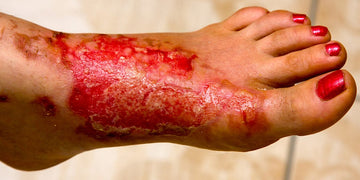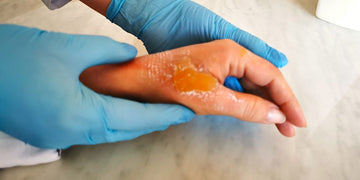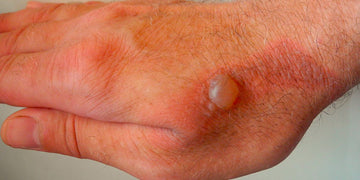A skin burn is a serious injury that can vary from minor to the most severe, like third-degree burns. While you may wonder whether a third-degree burn can heal on its own, others may wonder if it should be covered or uncovered. What about disinfecting it? What type of medicine is used for healing burns? Should you use cold water to cool a burn?
A third-degree burn can be so serious that it requires immediate professional medical attention. A medical professional diagnosing third-degree burns will know which treatment to begin with. Third-degree burn treatment consists of skin transplantation. However, healing is possible if you are treating third-degree burns with diligence. Below are some notes on how to treat a skin burn of the third degree.
Can a third-degree burn heal on its own?
If you have a third-degree burn, you need medical attention right away — it’s unlikely that your body will heal on its own in this case.
If you’ve suffered an electrical burn or chemical exposure that caused your skin to blister and peel off, these new layers of skin will grow back as second-degree burns before turning into full-thickness burns over time.
Third-degree burns are the most severe burns. They are so severe that they destroy skin tissue, fat, and even muscle below the skin’s surface. Third-degree burns require extensive medical treatment, including skin grafting. Most third-degree burns don’t heal independently because they damage too much tissue. But some may heal with time and proper care.
Treatment for third-degree burns will depend on where the burn is located, its size and depth, and whether there are any other injuries. Your doctor may prescribe pain medication, antibiotics, and other medications to help reduce swelling and third-degree burn infection(s). In severe cases, surgery may be required to remove damaged tissue from your body.
Third-degree burns are serious injuries that can lead to permanent disability or death if not treated properly and promptly.
Here are some tips to help a third-degree burn heal:
- Keep the wound moist by covering it with clean gauze or a cream that contains lanolin.
- Apply an antibiotic ointment to help prevent infection and keep out germs.
- Use sterile gauze pads to cover the wound until it stops oozing pus or fluid.
Causes of third-degree burns
Third-degree burns may be caused by:
- Chemical burns (such as hydrocarbons)
- Fire
- Electrical shock
- Scalding hot liquid or steam
- Sunlight or UV burns
Should a Third-degree Burn be Covered?
The answer is yes. Covering the wound with a clean dressing will help stop the bleeding from blood vessels damaged by heat in the deep layers of your skin. It also prevents dirt from entering the wound and causing infection. The dressing must be sterile to keep any infection from settling in.
How Long Do Third-degree Burns Take to heal?
A third-degree burn is often a combination of partial-thickness and full-thickness burns. Partial thickness burns involve only the top layer of skin (epidermis) and sometimes part of the second layer (dermis). Full-thickness burns involve all layers of the skin as well as underlying fat, muscle, and sometimes bone.
The severity of a third-degree burn depends on its size. A large area covers an entire limb or body part or more than 20% of the body surface area (BSA). For example, if you have a large area that covers your back or chest, it would count as an entire limb.
Third-degree burns take longer to heal than other burns because they destroy tissue and damage blood vessels that supply blood cells to heal wounds. They also interfere with your ability to sweat and regulate body temperature (thermoregulation).
The healing process for third-degree burns can take months or even years. The extent of the burn will determine how long it takes for your skin to heal.
What Ointment is Good for Treating Third-degree Burns?
The best treatment for third-degree burns is to get them treated by a doctor as soon as possible. The doctor will clean the burn area, dress it in gauze, and apply antibiotic cream or ointment. If you don’t have access to medical care, you can use over-the-counter (OTC) products such as Neosporin or Polysporin. These products will help prevent infection and promote healing. However, you should really consider using Vitastem Ultra which is 10x stronger and more effective than other brand name OTC antibiotics like Neosporin and Polysporin.
You should never put butter or oil on a burn because they trap heat in the skin, which can worsen the burn. Don’t even apply ice directly on your skin because it causes vasoconstriction (narrowing) of blood vessels, which reduces blood flow to the area, causing more damage than good.
Burn ointments. Applying a thin layer of petroleum jelly or other ointments to a third-degree burn may help decrease pain and prevent infection. You should not use any ointments that contain alcohol because they can make the injury worse.
Pain relievers. Taking acetaminophen (Tylenol) or ibuprofen (Advil) may help relieve some of your third-degree burn symptoms if they’re mild to moderate. However, if your pain is severe, you may need stronger pain relievers such as morphine sulfate (MS Contin), hydromorphone hydrochloride (Dilaudid), fentanyl citrate (Duragesic), or methadone hydrochloride (Dolophine). These drugs can be addictive and should be used only under a doctor’s supervision.
Antibiotics. If you have an open wound from a third-degree burn, it’s important to take antibiotics to prevent infection in the burned area and throughout your entire body. Antibiotics work best if they’re started within 24 hours after the initial burn.
Why is a third-degree burn so serious?
Third-degree burns are serious because they destroy the top layer of your skin (the epidermis) and the deeper layers (the dermis).
The dermis contains cells that produce collagen and elastin, giving your skin strength, flexibility, and elasticity. These cells are also responsible for healing damaged tissue in the body. When a third-degree burn destroys these cells, they cannot regrow. Instead, doctors must use a skin graft to replace them.
What happens if third-degree burns go untreated?
The longer you wait before treatment, the higher your risk of death due to shock (your body’s inability to regulate blood pressure), renal failure (kidney failure), becoming more susceptible to infection, and sepsis (blood poisoning).
Can you put Vaseline on third-degree burns?
Vaseline can be used on third-degree burns, but it must be used carefully because it can cause more harm than good if it is not applied properly.
Step 1: Keep the burn wound clean and dry with sterile gauze or cotton balls. Do not apply any other ointment or medication until you have spoken to your doctor or health care provider.
Step 2: Apply a thin layer of petroleum jelly to the affected area three times a day to help keep it moist and prevent infection from setting in. If the burn has become infected, your doctor may prescribe an antibiotic cream for use and painkillers such as acetaminophen or ibuprofen for relief from discomfort caused by the burn.
Which Ointment is best for burns?
A medical professional should determine care for a third-degree burn, as there are many factors to consider. After being discharged from a medical facility, you will need home care. An antibiotic ointment is necessary for the care of burn injuries.
Keep burns covered with sterile gauze bandages or cotton dressings until they heal enough not to weep fluid or pus anymore (usually within 24 hours). Then you can remove any dead tissue with tweezers or sterile scissors — but don’t use your fingers because they’re very sensitive.
Do burns heal faster, covered or uncovered?
You may be tempted to pop a blister or cut it open to let the fluid drain when you get a burn. But that’s not good for the wound — it could cause infection and slow healing.
The best treatment for most burns is to keep them clean, lightly bandaged, and covered by clothing that doesn’t pressure the wound. The exception is minor burns, such as sunburns, that don’t blister or heal properly. These can be treated with cool compresses applied daily until the skin heals.
What Medicine Heals Burns?
Topical antibiotic ointments and aloe or other burn creams can help the burns heal. However, third-degree burns require serious medical attention that is beyond what can be managed from home with a normal first aid kit. First aid for third-degree burns should be swift with medical attention and care.
How long should you keep a burn covered?
The best rule of thumb is to keep it covered until it’s healed. But there are some exceptions to that rule.
If it’s red and swollen, loosen the bandage after about an hour. If there’s no blistering or peeling (yet), then leave the bandage on for another day or two. It can take up to three days for a small burn to heal.
If your burn has blisters or oozing fluid, it needs immediate medical attention. Don’t try to pop the blisters yourself — this can cause infection. Don’t try anything at all without first seeking professional help from a doctor or nurse.
Third-degree burns fall into the latter category, where you need professional help.
After receiving medical attention for your burn, your doctor will likely tell you to keep it covered with gauze or sterile dressing until it heals completely. This helps prevent infection and keeps the wound moist so it can heal faster. Your doctor may also prescribe antibiotics if there is any risk of infection. There isn’t a specific length of time that applies to every person’s recovery from a third-degree burn.
Considering Vitastem for Treating Third-Degree Burns
Vitastem Ultra, which provides relief and healing for first, second, and third-degree burns, works 10x faster than other products (from 5 to 7 days to 12 hours). Bacitracin, the active ingredient in Vitastem Ultra, quickly kills all bacteria in the application area.
Normal conditions can harbor thousands of bacteria types in the human body. However, they are mostly harmless and may cause tissue damage. Vitastem Ultra, which has a dual carrier action, quickly delivers the active ingredient of this third-degree burn ointment deep into injury tissue to restore damaged and weakened tissues.
Vitastem also contains ingredients that surgeons use to promote blood flow to tissues recovering from surgery trauma. The same formula can also be used in plastic surgery to promote scarring reduction and accelerate healing.
Using a very specialized blend of ingredients, Vitastem has created an advanced topical drug delivery delivery formula that allows the medicine to be delivered at 10x the strength and depth of other products on the market today. The formula stimulates skin cells to make them more permeable, allowing more medicine to be absorbed into the cell. This kills bacteria and makes them incapable of adapting and developing resistance. Vitastem Ultra patients have seen rapid results from this highly concentrated and fast medicine delivery to needy areas.
Vitastem Ultra kills all harmful bacteria and infuses skin cells with vitamin D3 or vitamin C (ascorbic acids). The burn will be left treated and the skin rejuvenated.







